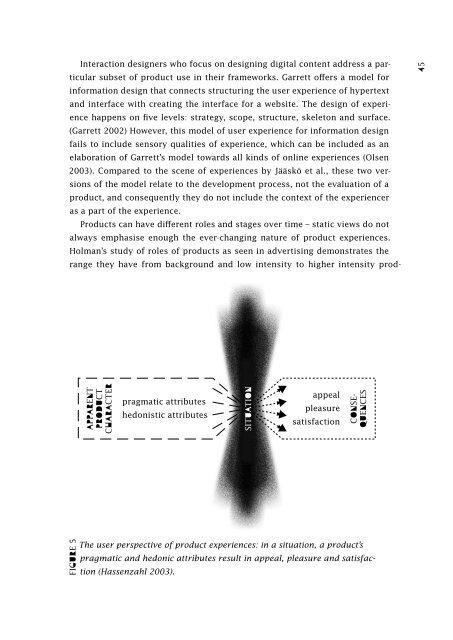Co-experience: Understanding user experiences in social interaction
Co-experience: Understanding user experiences in social interaction
Co-experience: Understanding user experiences in social interaction
Create successful ePaper yourself
Turn your PDF publications into a flip-book with our unique Google optimized e-Paper software.
Interaction designers who focus on design<strong>in</strong>g digital content address a particular<br />
subset of product use <strong>in</strong> their frameworks. Garrett offers a model for<br />
<strong>in</strong>formation design that connects structur<strong>in</strong>g the <strong>user</strong> <strong>experience</strong> of hypertext<br />
and <strong>in</strong>terface with creat<strong>in</strong>g the <strong>in</strong>terface for a website. The design of <strong>experience</strong><br />
happens on five levels: strategy, scope, structure, skeleton and surface.<br />
(Garrett 2002) However, this model of <strong>user</strong> <strong>experience</strong> for <strong>in</strong>formation design<br />
fails to <strong>in</strong>clude sensory qualities of <strong>experience</strong>, which can be <strong>in</strong>cluded as an<br />
elaboration of Garrett’s model towards all k<strong>in</strong>ds of onl<strong>in</strong>e <strong>experience</strong>s (Olsen<br />
2003). <strong>Co</strong>mpared to the scene of <strong>experience</strong>s by Jääskö et al., these two versions<br />
of the model relate to the development process, not the evaluation of a<br />
product, and consequently they do not <strong>in</strong>clude the context of the <strong>experience</strong>r<br />
as a part of the <strong>experience</strong>.<br />
Products can have different roles and stages over time – static views do not<br />
always emphasise enough the ever-chang<strong>in</strong>g nature of product <strong>experience</strong>s.<br />
Holman’s study of roles of products as seen <strong>in</strong> advertis<strong>in</strong>g demonstrates the<br />
range they have from background and low <strong>in</strong>tensity to higher <strong>in</strong>tensity prod-<br />
45<br />
APPARENT<br />
PRODUCT<br />
CHARACTER<br />
pragmatic attributes<br />
hedonistic attributes<br />
SITUATION<br />
appeal<br />
pleasure<br />
satisfaction<br />
CONSE-<br />
QUENCES<br />
FIGURE 5<br />
The <strong>user</strong> perspective of product <strong>experience</strong>s: <strong>in</strong> a situation, a product’s<br />
pragmatic and hedonic attributes result <strong>in</strong> appeal, pleasure and satisfaction<br />
(Hassenzahl 2003).

















